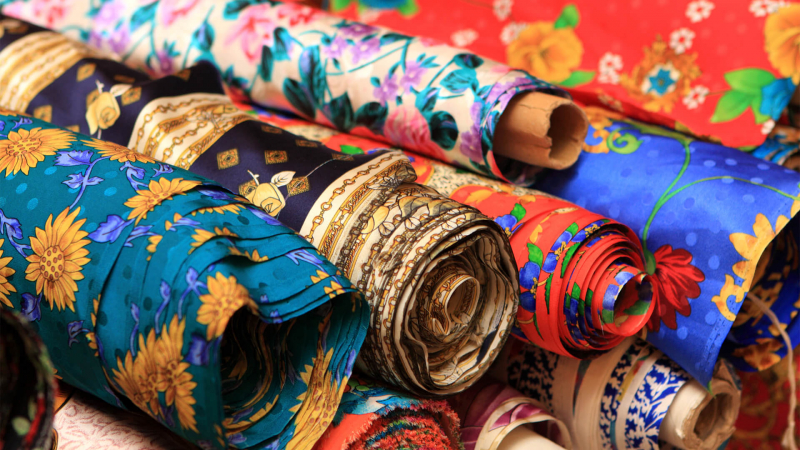Chinese Silk
Silk is a fine, smooth material made from mulberry silkworm cocoons, which are soft protective shells (insect larvae). According to legend, silkworms were discovered by Lei Tzu, the wife of the Yellow Emperor, who ruled China around 3000 BC. According to one version of the story, while walking through her husband's gardens, she discovered that silkworms had destroyed several mulberry trees. She gathered a number of cocoons and sat down to rest. While she was drinking her tea, one of the cocoons she had collected landed in the hot tea and began to unravel into a fine thread. Lei Tzu discovered she could wrap her fingers with this thread. She then convinced her husband to give her permission to raise silkworms in a grove of mulberry trees. In order to make the cocoon's fibers strong enough to be woven into cloth, she also created a unique reel to draw them out as a single thread. Although it is unclear how much of this is accurate, it is undeniable that silk has been grown in China for many centuries.
Originally, silkworm farming was restricted to women, who were responsible for growing, harvesting, and weaving. Silk quickly became a status symbol, and originally, only royalty were permitted to wear silk clothing. Over time, the rules were gradually relaxed until, during the Qing Dynasty (1644—1911 AD), even peasants, the lowest caste, were permitted to wear silk. Silk was so valuable during the Han Dynasty (206 BC-220 AD) that it was used as a unit of currency. Government employees were paid in silk, and farmers paid their taxes in grain and silk. The emperor also used silk as diplomatic gifts. Silk has been used to create paper, musical instruments, fishing lines, and bowstrings. The first evidence of silk paper use was found in a nobleman's tomb who is said to have passed away around 168 AD.
The lucrative trade route now known as the Silk Road, which took silk westward and brought gold, silver, and wool to the East, was eventually created by demand for this exotic fabric. The Silk Road was named after its most valuable commodity, which was thought to be more valuable than gold.
The Great Wall of China, the Pamir mountain range, modern-day Afghanistan, and the Middle East were all part of the roughly 6,000-kilometer Silk Road, which began in Eastern China and ended at the Mediterranean Sea. Damascus served as a significant trading hub along the route. The goods were then transported across the Mediterranean Sea from there. Few businesspeople traveled the entire route; instead, most commodities were handled by a network of middlemen.
Because the mulberry silkworm is indigenous to China, the country was the sole producer of silk for hundreds of years. The Byzantine Empire, which ruled over the Mediterranean region of southern Europe, North Africa, and the Middle East from 330 to 1453 AD, eventually spread the secret of silk-making to the rest of the world. Another legend has it that in 550 AD, monks working for the Byzantine emperor Justinian smuggled silkworm eggs to Constantinople (Istanbul in modern-day Turkey) hidden inside hollow bamboo walking canes. However, the Byzantines were just as secretive as the Chinese, and the weaving and trading of silk fabric was a strict imperial monopoly for many centuries.
The Arabs later conquered Persia in the seventh century, taking their fine silks with them.
As the Arabs swept across these countries, silk manufacture subsequently extended throughout Africa, Sicily, and Spain. In the tenth century, Andalusia in southern Spain served as Europe's primary silk-producing region. But by the thirteenth century, Italy was the continent's top producer and exporter of silk. Venetian traders engaged in substantial silk trading and promoted the relocation of silk cultivators to Italy. Even today, the province of Como in northern Italy is renowned for its silk processing.
The European silk industry was destroyed by the nineteenth century and industrialization. One of the many factors driving the trend was cheaper Japanese silk, trade in which was greatly facilitated by the opening of the Suez Canal. Then, in the twentieth century, new manmade fibers like nylon began to be used in what had previously been silk products like stockings and parachutes. The European silk industry was also stifled by the two world wars, which disrupted the supply of raw materials from Japan. After WWII, Japan's silk production was restored, with improved raw silk production and quality. Until the 1970s, Japan was the world's largest producer of raw silk and practically the only major exporter of raw silk. However, China has progressively regained its status as the world's largest producer and exporter of raw silk and silk yarn in more recent decades. Around 125,000 metric tons of silk are produced globally each year, with China accounting for over two-thirds of that total.










